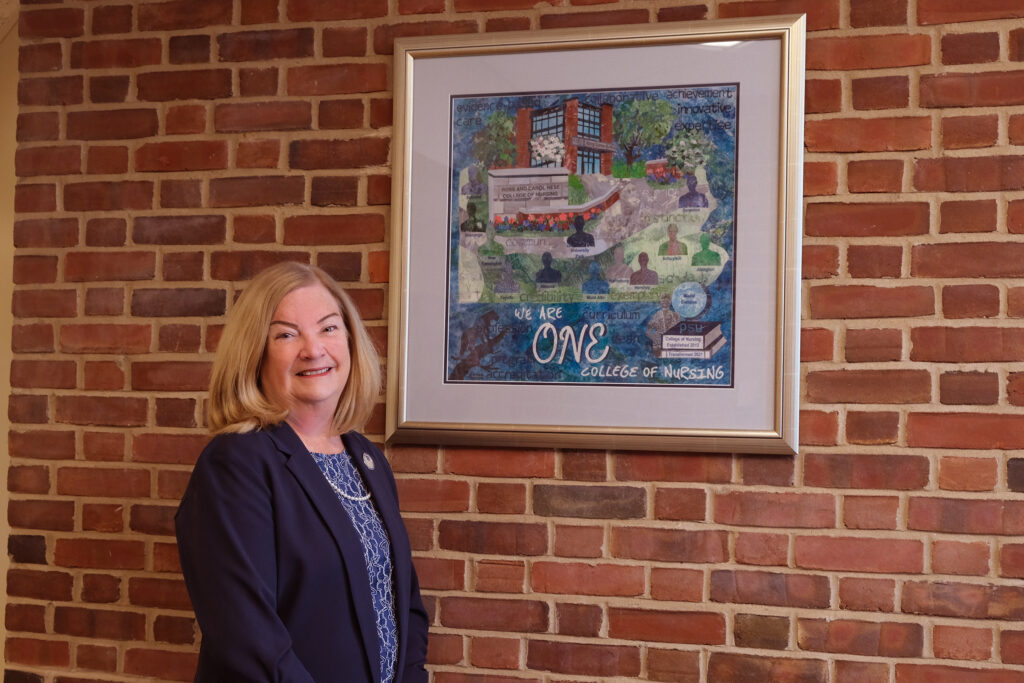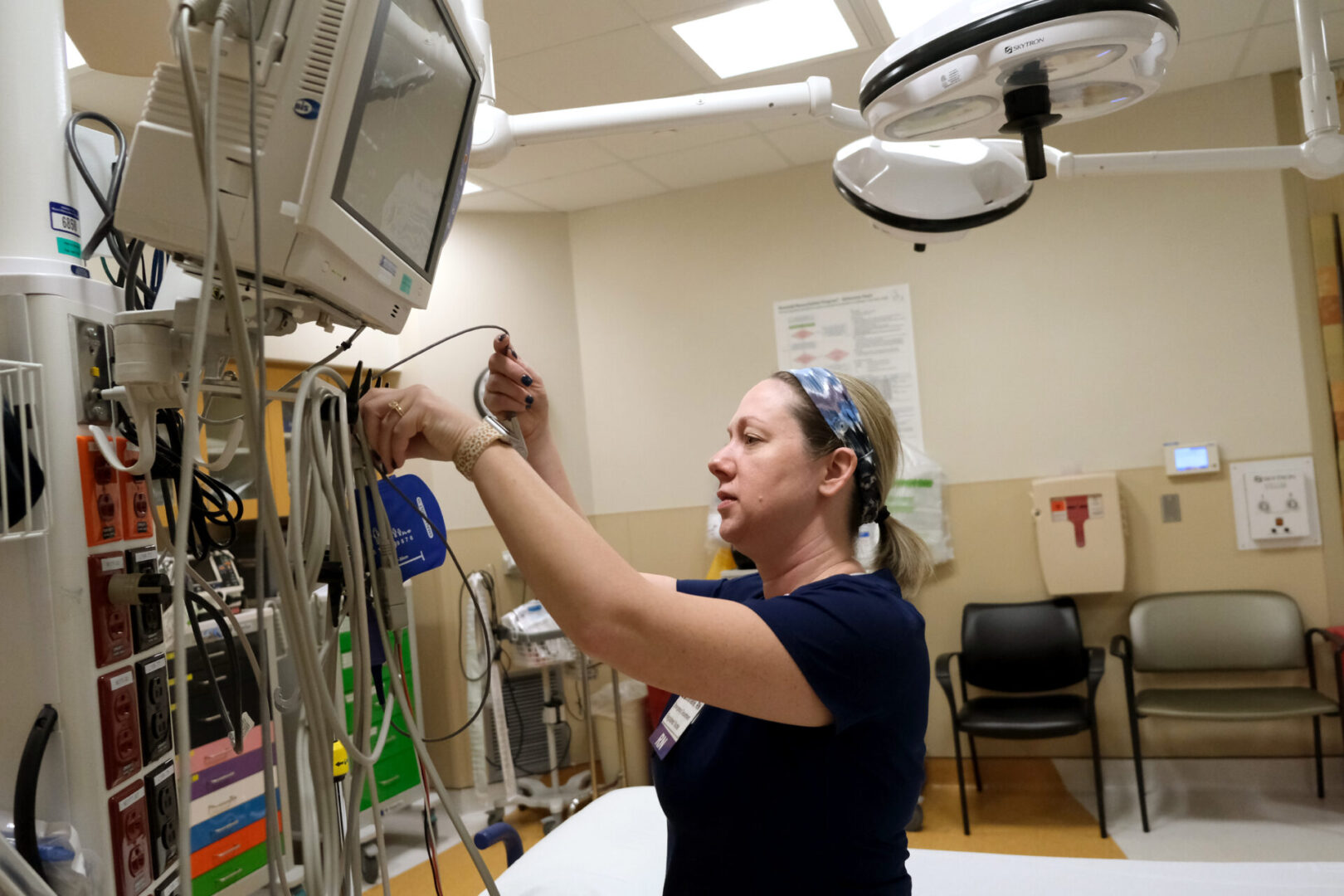“It’s an exciting time to become a nurse.”
So says Laurie Badzek, dean of Penn State’s Ross and Carol Nese College of Nursing, in spite of—and in some instances, perhaps even as a result of—many pandemic-related disruptions to the field.
The biggest disruption has been the same issue afflicting a wide range of industries across the country: a substantial labor shortage. Factors like high stress conditions, illness, and burnout led many health care workers to join The Great Resignation, exacerbating what the U.S. Department of Health and Human Services had already been reporting before the pandemic as a widening gap between supply and demand for registered nurses.
“We do have a significant shortage. I’m going to acknowledge that. I think we have seen at least a ten percent increase in the number of open positions in Pennsylvania,” Badzek says.
In fact, she cites a recent report released by the Hospital and Healthsystem Association of Pennsylvania (HAP), which states that Pennsylvania currently has the highest shortage of registered nurses in the nation.
“Resolving the shortage, especially in nursing, is going to have to be really multifaceted,” Badzek says. “It really is incumbent on everyone—the educators, the government, as well as the employers—to help to provide the incentives to keep nurses in the state.”

Show them the money
At the top of the list for those incentives has to be compensation, Badzek says.
“One of the things they [HAP] noted was most successful for recruitment and retention of nurses and other health care employees was increasing their base compensation. That’s the number one strategy,” she says. “The other piece that is important in terms of what we are seeing is giving them the professional development and tuition reimbursement that they need to advance.”
At the state government level, Governor Josh Shapiro has proposed a three-year tax credit of up to $2,500 for newly certified nurses, teachers, and police officers, an initiative Badzek hopes will pass.
Locally, health care providers are doing their part to attract and retain employees, and so far, their efforts appear to be paying off.
Mount Nittany Health, which currently employs 527 RNs and 56 licensed practical nurses system-wide, is “in a good place,” says Amy Trithart, chief human resource officer.
“Of course Mount Nittany Health has been affected by labor shortages. But currently our number of open nurse positions is less than what others are seeing,” she says. “The average employee tenure here is over eight years, which is pretty unheard of in health care across the nation. That hasn’t changed much over the past few years, so we are very, very fortunate.”
Mount Nittany Health has created its own good fortune in some ways by offering incentives including sign-on bonuses to new employees, and referral bonuses to staff whose recommendations lead to the hiring of new registered nurses, Trithart says.
In addition, Mount Nittany offers tuition reimbursement for continuing education programs and provides funds for employees working on nursing certifications.
Similarly, Geisinger is also having success with keeping nursing vacancies to a minimum in the region.
According to Stacey Osborne, chief nursing officer at Geisinger Lewistown Hospital, “We are in a much better position on this side of COVID than we were a few years ago. We have had a great hiring season over the last year.”
Geisinger Lewistown currently employs 240 RNs and 20 LPNs, while the two major Geisinger locations in State College (Geisinger Healthplex and Geisinger Scenery Park) employ an additional 165 nurses. Like Mount Nittany Health, Geisinger has been offering sign-on bonuses and tuition reimbursement for continuing education.
As important as it is to compensate working nurses well, it is also crucial to find ways to make a nursing education more affordable and accessible to future nursing students, Badzek says.
“A nursing education is very expensive. Nurses are among the students who leave with the greatest amount of debt and pay the highest in tuition, which seems really unfair,” she says.
Penn State’s nursing college includes four-year baccalaureate nursing programs at six commonwealth campuses, in addition to University Park. While the University Park and Altoona campuses receive far more applicants than they can accommodate, Badzek says the other campuses have open seats.
“Especially in the most rural areas and in the lower-income areas, we have seen a decrease in the number of students applying,” Badzek says.
In order to make the major more affordable in those areas, she says, “We really need support, such as from individual donors who are going to give scholarships to students. For example, the Neses, who named our college, gave enough scholarship money to us that we can distribute to all of the campuses. These are $10,000 scholarships, so they are significant. We need more of that kind of support.”
Geisinger Lewistown Hospital has its own accredited nursing school, and Osborne says Geisinger offers financial support in many forms to accommodate students in the program.
“We are dedicated to helping those who would like to become a nurse to be successful with that,” Osborne says. “We know that there are several different avenues and ways to become a nurse, and Geisinger is fortunate enough to have been able to come up with some different pathways.”
That includes a Nursing Scholars program, offering current Geisinger employees who wish to attend nursing school significant financial support with a five-year work commitment as an inpatient nurse; and a School at Work program for current support staff who are interested in refining skills in preparation for entering nursing school. Geisinger also has redesigned some of its curriculum to reduce the time it takes for an LPN to earn an RN degree.
The travel trend
If compensation is the most important factor in attracting and retaining nurses, the second most important consideration is a flexible work schedule, Badzek says.
As nursing shortages deepened during the pandemic, a new employment opportunity arose for those seeking more control over their schedules. Health care providers increasingly turned to the use of short-term agency nurses, also known as “travel nurses,” to fill voids in their staff.
At the height of the pandemic, Geisinger Lewistown Hospital employed almost 40 agency nurses at once, Osborne says. As of April, they only had one.
While the need for travel nurses may have declined since the height of the pandemic, Badzek says, “I think they’re here to stay. It’s a new way for people to work. There is a significant number of nurses who want that opportunity to be flexible and choose when they work.”
Danielle Luzier, RN, started working as a travel nurse at the beginning of the pandemic, taking assignments at facilities within a sixty-mile radius of her home in Lock Haven.
“The biggest perk was the flexibility,” she says.
Luzier says the hardest part was being thrown into new environments with just one or two days to familiarize herself with different computer systems or policies, but “you learn a lot, and you get to take that knowledge with you to the next place.”
Eventually, Luzier was assigned to the Emergency Department at Mount Nittany Medical Center, where she ultimately decided to accept a permanent position.
“Travel was great in that regard. I got to test out the ERs in the area, and I got to see where I felt that I fit best,” she says.
Intangible incentives
Luzier says she appreciated Mount Nittany’s emphasis on patient safety, the relatively low patient-to-nurse ratio, and “feeling like someone always had my back, and they made me feel welcome.”
Badzek believes that an overall good feeling about co-workers and the facility as a whole is a crucial factor nurses should consider when deciding where to work.
“I’ve always used the term ‘magnet environment.’ I tell students to look for a place you are attracted to, a place where you can “stick” and be well and high-functioning for a long period of time,” she says.
Some institutions go through a lengthy accreditation process to become officially designated as “Magnet Hospitals,” but Badzek believes many hospitals that do not go through the process are still good magnet environments. She says these are places that clearly follow the code of ethics for nursing and promote health and wellness for their employees.
Trithart believes nurses are attracted to some of these intangibles at Mount Nittany Health.
“In this market, health care workers are looking for places to come where they can have some balance in their work life, a comfortable work space, and a place to take a break. Mount Nittany has invested in things like new building improvements, break rooms, green space, and equipment. We’re really excited about all of those new things,” Trithart says.
Geisinger is also focusing on employees’ wellness.
“COVID has really brought about the need for us to focus on our own self-care and our mental health and well-being,” Osborne says. “I think Geisinger is doing a tremendous job at helping us all to recognize that we need to be aware of that.”
Looking to the future
With an aging population, the demand for nurses is not going to be declining in the foreseeable future, so Badzek says leaders in the health care industry need to be working on solutions now.
“Nurses make up the highest number of employees in any hospital setting, so we need to work together to make sure nursing is getting what it needs,” she says.
As Mount Nittany Health leaders look to the future, Trithart says, they are focused on developing a pipeline of future nurses.
“We’ll continue to do our part to encourage people to explore the nursing career. We have a couple of different programs for high school students to rotate through, and we will keep our [college-level] nursing programs going, where nursing students can continue to come here for their nursing rotations. We’ll continue to do everything we can to recruit and retain those nurses for our system, because we really want to keep our commitment to the community,” she says.
Badzek believes those students who do decide to pursue a nursing career will not regret it.
“The most trusted profession in the United States today, and for twenty years running, has been nursing. So, people who want to go into a profession where they are going to be respected will pick nursing,” she says. “I think it is a terrific place for young people to look for what they might do when they grow up. It’s one of the most satisfying professions you can select.”
Luzier agrees.
“I think nursing is one of the most rewarding careers that you can have. It’s a privilege to care for patients during what is oftentimes the most scary or vulnerable or unexpected moments in their life, and they put their faith in you as their nurse to keep them safe and calm,” she says. “There’s just no higher honor than to care for people in that way.” T&G
Karen Walker is a freelance writer in State College.



